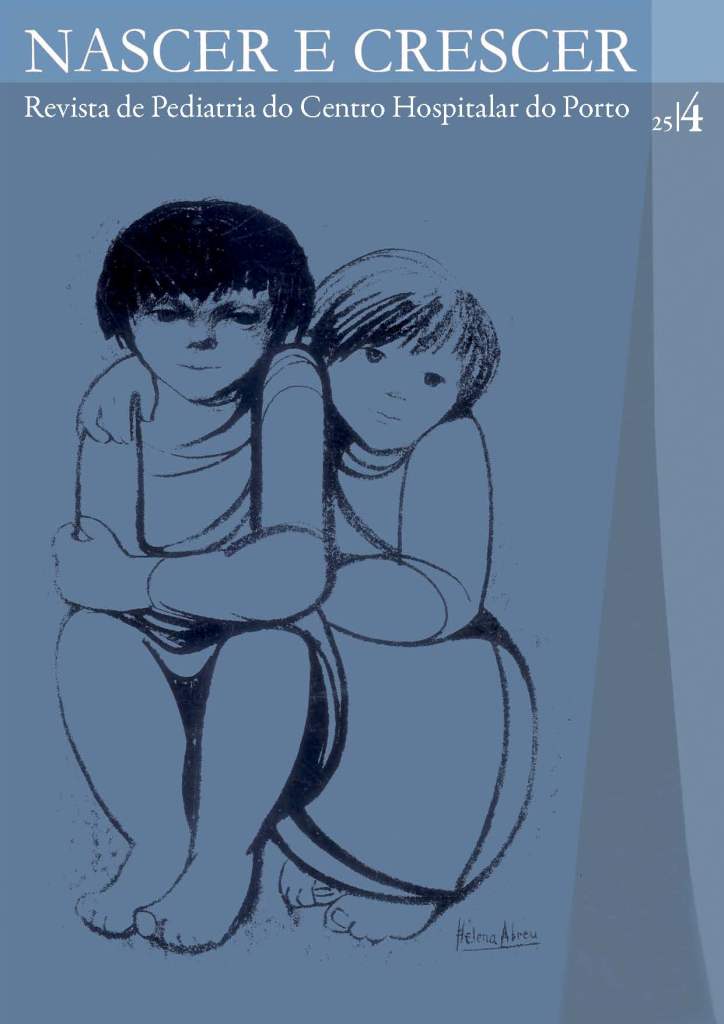ULCERATIVE INFANTILE HEMANGIOMA – IS THERE AN ALTERNATIVE TO PROPRANOLOL?
DOI:
https://doi.org/10.25753/BirthGrowthMJ.v25.i4.10804Keywords:
hemangioma, topical treatment, timolol, beta-blocker, childAbstract
Introduction:Infantile hemangiomas (IH) affect nearly 5% of caucasian children, being ulceration their main complication. In the last years, systemic or topical beta-blockers became the first-line treatment of IH. However, controversy remains about the use of topical timolol in complicated IH.
Case report:A six-month-old child was referred to our General Pediatrics outpatient clinic with an ulcerative, erythematous and painful lesion located at the lumbar region. Soft tissue ultrasound confirmed the diagnosis of hemangiomatous tumefaction (31x19x20mm), with extension to muscular groups. Treatment with topical timolol 0.5% (eye drops) was started; three months later there was a complete healing of ulcerative region of IH, whose size remained stable.
Conclusion: The authors highlight the potential use of timolol in ulcerative IH. In the present case it proved to be effective, and without adverse effects.
Downloads
References
Kilcline C, Frieden IJ. Infantile hemangiomas: how common are they? A systematic review of medical literature. Pediatr Dermatol 2008; 25(2):168-73.
Kim LHC, Hogeling M, Wargon O, Jiwane A, Adams S. Propranolol: useful therapeutic agent for the treatment of ulcerated infantile hemangiomas. J Pediatr Surg 2011; 46:759-63.
Chan LC, Haggstrom AN, Drolet BA, Baselga E, Chamlin SL, Garzon MC et al. Growth characteristics of infantile hemangiomas: implications for management. Pediatrics 2008;122:360–7.
Pandey A, Gangopadhyay AN, Sharma SP, Kumar V, Saroj Gopal C, Gupta DK. Conservative management of ulcerated jaemangioma – twenty years experience. Int Wound J 2009; 6:59-62.
Drolet BA, Frommelt PC, Chamlin SL, Haggstrom AN, Bauman NM, Chiu YE et al. Initiation and Use of Propranolol for Infantile Hemangioma: report of a Consensus Conference. Pediatrics 2013;131:128-40.
Chan H, McKay C, Adams S, Wargon O. RCT of Timolol Maeleate Gel for Superficial Infantile Hemangiomas in 5- to 24-Week-Olds. Pediatrics 2013;131:1739-47.
Sans V, de la Roque ED, Berge J, Grenier N, Boralevi F, Mazereeuw-Hautier J et al. Propranolol for severe infantile hemangiomas: follow-up report. Pediatrics 2009; 124:423-31.
Schiestl C, Neuhaus K, Zoller S, Subotic U, Forster-Kuebler I, Michels R et al. Efficacy and safety of propranolol as first-line treatment for infantile hemangiomas. Eur J Pediatr. 2011;170:493-501.
Chim H, Armijo BS, Miller E, Gliniak C, Serret MA, Gosain AK. Propranolol induces regression of hemangioma cells through HIF-1α-mediated inhibition of VEGF-A. Ann Surg. 2012;256:146-56.
Fernandes S, Amaro C, Cardoso J. Hemangioma infantil ulcerado do sulco interglúteo tratado com timolol tópico. Revista SPDV 2013;71:285-7.
Cante V, Pham-Ledard A, Imbert E, Ezzedine K, Léauté-Labrèze C. First report of topical timolol treatment in primarily ulcerated perineal haemangioma. Arch Dis Child Fetal Neonatal 2012;97:155-6.
Chakkittakandiyil A, Phillips R, Frieden IJ, Siegfried E, Lara-Corrales I, Lam J et al. Timolol maleate 0.5% or 0.1% gel-forming solution for infantile hemangiomas: a retrospective, multicenter, cohort study. Pediatr Dermatol 2012; 29:28-31.
Moherle M, Léauté-Labrèze C, Schmidt V, Röcken M, Poets CF, Goelz R. Topical timolol for Small Hemangiomas of Infancy. Pediatr Dermatol 2013; 30:245-9.
Thomas J, Kumar P, Kumar DD. Ulcerated Infantile Haemangioma of Buttock Successfully Treated With Topical Timolol. J Cutan Aesthet Surg 2013;6:168-9.
Chang CS, Kang GCW. Healing of Ulcerated Infantile Hemangiomas Using Topical Timolol Plast Reconstr Surg Glob Open. 2016 Feb 16;4:621.
Downloads
Published
How to Cite
Issue
Section
License
Copyright and Authors' Rights
All articles published in Nascer e Crescer - Birth and Growth Medical Journal are Open Access and comply with the requirements of funding agencies or academic institutions. For use by third parties, Nascer e Crescer - Birth and Growth Medical Journal adheres to the terms of the Creative Commons License "Attribution - Non-Commercial Use (CC-BY-NC)".
It is the author's responsibility to obtain permission to reproduce figures, tables, etc. from other publications.
Authors must submit a Conflict of Interest statement and an Authorship Form with the submission of the article. An e-mail will be sent to the corresponding author confirming receipt of the manuscript.
Authors are permitted to make their articles available in repositories at their home institutions, provided that they always indicate where the articles were published and adhere to the terms of the Creative Commons license.


